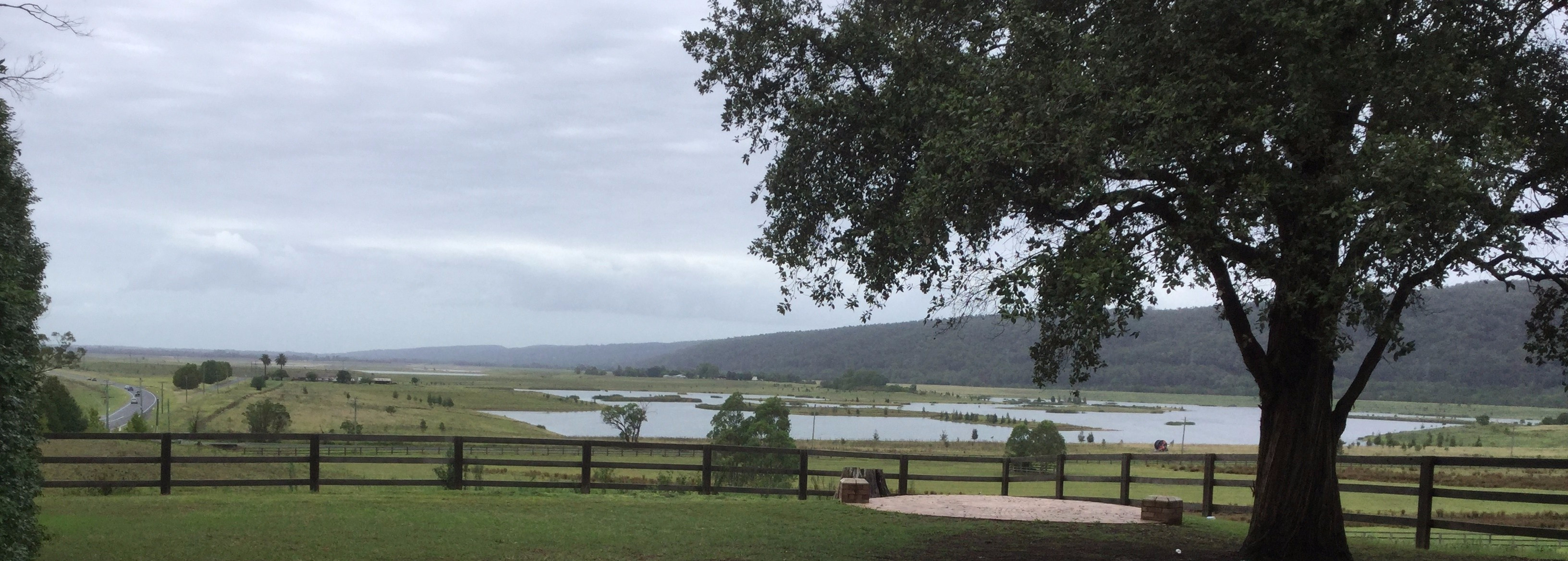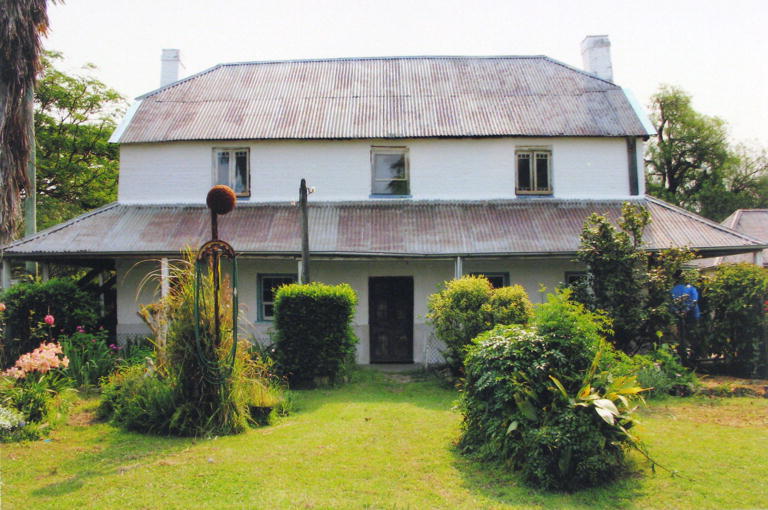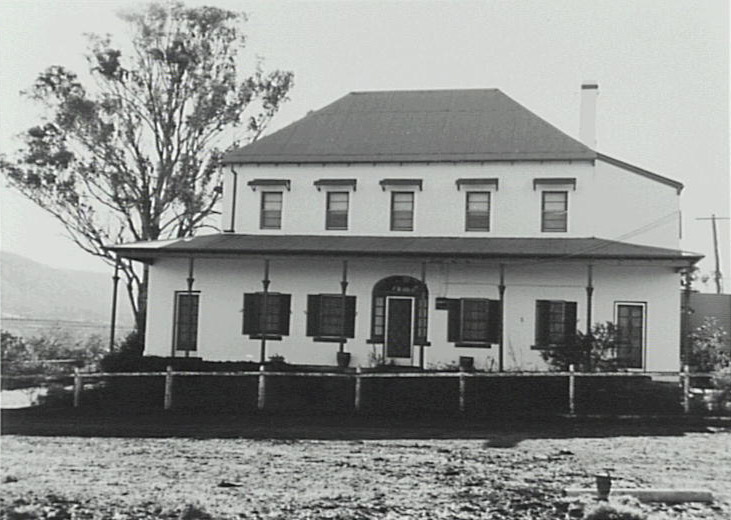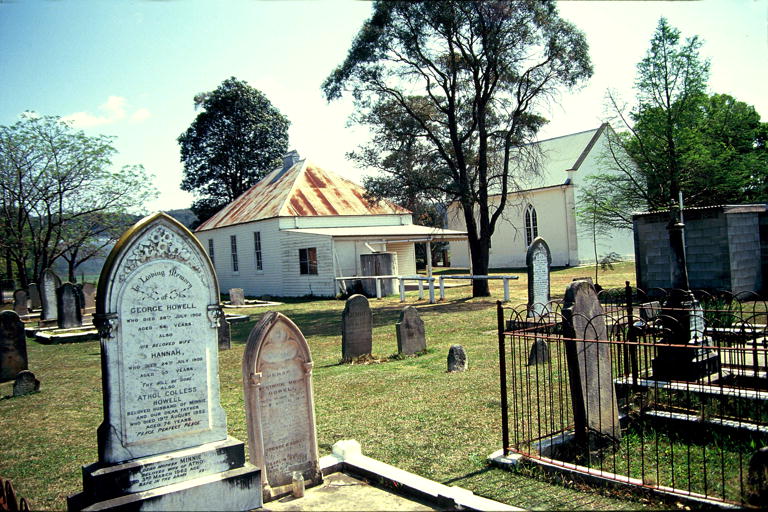Penrith City Local History - Places - Suburb profiles - Castlereagh
Castlereagh
Castlereagh is located east of the Nepean River north of Penrith. This suburb is one of the most historic sites in Australia’s history, being one of Governor Lachlan Macquarie’s five towns founded in 1810. After two hundred years, the rich river flats continue to provide for a thriving agricultural industry along the Nepean River. Many of this district’s pioneering families originated from Castlereagh. The suburb’s historical importance is reflected in its many surviving farmhouses, outbuildings, churches and cemeteries. Castlereagh Road is an important transport link connecting the Hawkesbury and Penrith regions. The impact of the massive Penrith Lakes Scheme has, and will in the future, change the face of Castlereagh and its neighbouring suburbs.

Castlereagh on Google Maps
Circumstances however, ensured that Penrith, not Castlereagh, became the focal point of the area and this site was never developed. The present township is located five kilometres away from Macquarie’s original site.

Nepean Park: Home of the family of John Single. John Single acquired Nepean Park in 1819 and the house was built 1822. John Single was one of the most successful pioneers in the Nepean district. He made full use of new scientific methods in agriculture and grazing. He built a school on his property and supported the building of the Castlereagh Anglican Church.

Christ Church Anglican Church: The first Anglican Church was built in 1813 within the surveyed town of Castlereagh. This church was destroyed by fire in the early 1870s. Christchurch was consecrated in 1878 and is located in Church Lane overlooking the fertile river flats.






Upper Castlereagh Methodist Church & Cemetery: The land on which the first Wesleyan Church built in Australia stands was part of a grant to John Lees in 1804. In 1817, the small chapel was opened. In 1848, the Church was replaced by the present stuccoed building. The cemetery was opened in 1836.

Castlereagh Hall: Formerly Castlereagh Council Chambers.The Municipality of Castlereagh was proclaimed in 1895. This building was built as part of the Council’s depression relief during the early 1930s. The municipality was amalgamated with Penrith Council in 1949.

| 1799 | A major flood of the Nepean River | |
| 1803 | 1 July | Mary Collett received a land grant at 'Birds Eye Corner' |
1804 | 4 June | John Lees received land grant at Castlereagh. Later he gave part of this grant for a Methodist Church to be erected |
| 1804 | 11 August | James McCarthy received land grant which he later named Crane Brook Farm |
| 1806 | A major flood of the Nepean River | |
| 1809 | A major flood of the Nepean River | |
| 1810 | 6 December | Governor Lachlan Macquarie named Castlereagh as one of his five towns |
| 1811 | Surveyor James Meehan marked out the streets and square | |
| 1811 | A major flood of the Nepean River | |
| 1814 | 28 April | A glebe house and school completed for Rev. Henry Fulton in Church Street |
| 1814 | 11 July | Rev. Henry Fulton's school opened. Called the Classical Academy for Young Gentlemen, this school was the first secondary school in Australia |
| 1814 | First burial in Castlereagh Anglican cemetery | |
| 1817 | 7 October | The first Methodist chapel in the southern hemisphere was opened, erected by John Lees |
| 1818 | 4 January | James Tobias 'Toby' Ryan born at Castlereagh |
| 1822 | John Single built 'Nepean Park' | |
| 1825 | Rev. Henry Fulton's school was closed | |
| 1826 | 22 February | Joseph Daniel Single born |
| 1836 | 4 August | Ann Fulton, wife of Henry Fulton died |
| 1836 | John Lees died at Castlereagh | |
| 1840 | 17 November | Rev. Henry Fulton died and is buried at Castlereagh Cemetery on the 19th Nov |
| 1848 | Methodist Chapel opened - the second on the site | |
| 1858 | 1 May | Castlereagh School opened. It closed in 1935 |
| 1878 | 11 December | Christchurch Anglican Church was consecrated. This church replaced Fulton's church in Church Street which had been destroyed by fire |
| 1878 | 28 January | John Single of 'Nepean Park' estate died |
| 1879 | 3 March | Upper Castlereagh School opened. It closed in 1975 |
| 1895 | 9 September | Municipality of Castlereagh proclaimed |
| 1911 | 26 September | William Hart flew over Castlereagh and up the river to Edinglassie, the first aeroplane flight in the district |
| 1923 | First cotton grown in Australia at Castlereagh by G. A. Bond & Co. on the corner of Church Lane and Castlereagh Road | |
| 1935 | 17 December | Castlereagh School closed |
| 1948 | 12 August | Announced that Castlereagh Council would amalgamate with Penrith not Windsor and Richmond as previously recommended |
| 1948 | December | Elections held for the new Council |
| 1949 | 1 January | Castlereagh, Mulgoa, St. Marys and Penrith Shires amalgamated to form the Municipality of Penrith |
| 1957 | The present Castlereagh School erected | |
| 1980 | Penrith Lakes Scheme established | |
| 1995 | June | Development Application (DA3) to quarry 403 ha was approved |
| 2019 | The State Government acquires Hadley House from the Penrith Lakes Development Corporation. |
